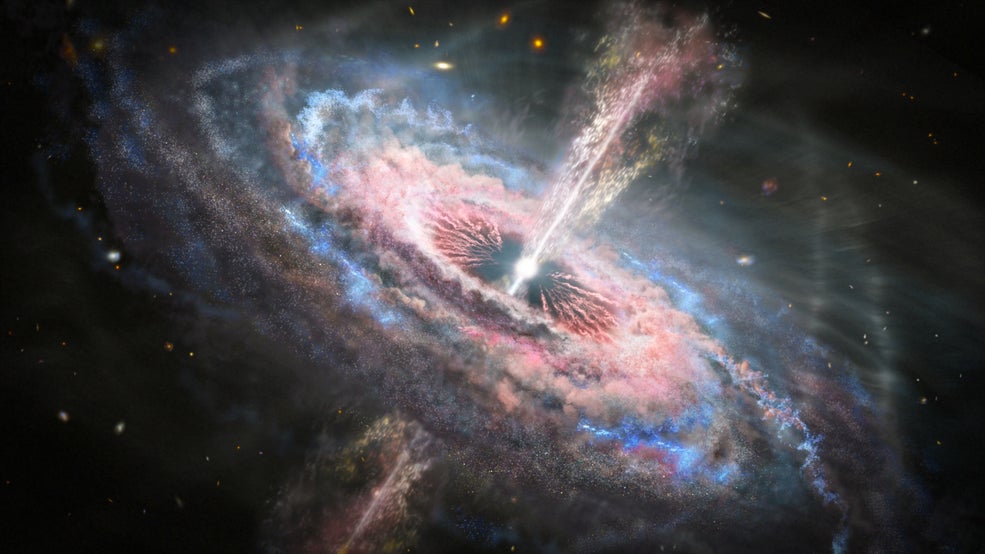More than 20,000 galaxies shine brightly in this sweeping view of the sky between the constellations Pisces and Andromeda. But more than just a captivating sight, the view has helped astronomers determine what sparked the era of reionization, the period when the opaque universe gave way to the transparent one.
The early days of the universe were shrouded in thick gas that limited the amount of light that could travel through it. during the The era of reionization– When the universe was about 400 million to a billion years old – the gaseous universe began to clear, until everything became transparent to light.
And so the era of reionization was crucial to our ability to see what happened. Square kilometer array — the It will soon be the largest radio telescope in the world—this made the nebulous time period his focus.
It has now been some 13.7 billion years since the Big Bangand Webb has the concept of looking back at those early ages to understand exactly what has changed.
In the center of the image above is a pink light source with six diffraction spines (artifacts from Webb’s imaging). The source of the light is quasar J0100+2802, an unusually bright galactic nucleus that lights up the gas between it and Webb.
The composite image includes many exposures by Webb’s NIRCam instrument, and can be viewed through various filters; All exposures were taken on August 22, 2022. Our website can only handle a smaller version of the image; You can see it in its 127MB glory here.
A team of astronomers — Face to Face Webb — has used quasar light to study more than 100 galaxies from the universe’s first billion years, focusing on 59 galaxies that lie between the quasar and the telescope.

We expected to identify a few dozen galaxies that existed during the era of reionization–“But we could easily pick 117,” said Daichi Kashino, an astronomer at Nagoya University and lead author of one of the papers. “Webb has exceeded our expectations.”
The researchers compared Webb’s data with previous observations of the quasar taken by the Keck Observatory, the European Southern Observatory’s Very Large Telescope, and the Las Campanas Observatory’s Magellan Telescope.
Their findings are published in three separate papers, today in The Astrophysical Journal. One paper focused on Evidence for reionization driven by young galaxiesdescribe the second Spectroscopy of stars and gases in galaxiesA third focused on The quasar is central to the entire investigation.
The researchers found that the regions around the galaxies were transparent bubbles, indicating that the galaxies themselves were involved in the re-ionization of the universe.
“When we look back at the reionization teeth, we see a very clear change,” said study co-author Simon Lilly, an astronomer at ETH Zürich in Switzerland, and lead researcher, at the Space Telescope Science Institute. launch. “The galaxies, which are made up of billions of stars, ionize the gas around them, effectively turning it into a transparent gas.”
The light from the quasar showed precisely where it was being absorbed by the gas (meaning the region had not yet been reionized) or continued traveling (meaning the region was more transparent). The transparent regions around galaxies were generally about 2 million light-years across, according to the same version.
The transparent regions around the galaxies swelled and coalesced, finally making the entire universe transparent.
One notable element that Webb alone cannot decipher is how the luminous quasar got so large early in the evolution of the universe. The mass of J0100+2802 is about 10 billion times that of the Sun. How black holes evolve is still a baffling question, as astrophysicists have yet to understand how supermassive black holes become such, and Why do there seem to be very few intermediate mass black holes? (While there are a large number of star clusters and massive ones.)
Webb is a bit of a tear-jerker when it comes to deep imaging of ancient galaxies. Just last week a A deep field with twice as many galaxies (45,000 galaxies in total) The image above has also been edited.
Webb’s outlook is unwavering, and as dozens of researchers sift through his data, the evolution of the early universe–once a vague mess–is crystallized.
More: Astrophysicists discover the closest black hole to Earth

“Beer aficionado. Gamer. Alcohol fanatic. Evil food trailblazer. Avid bacon maven.”
